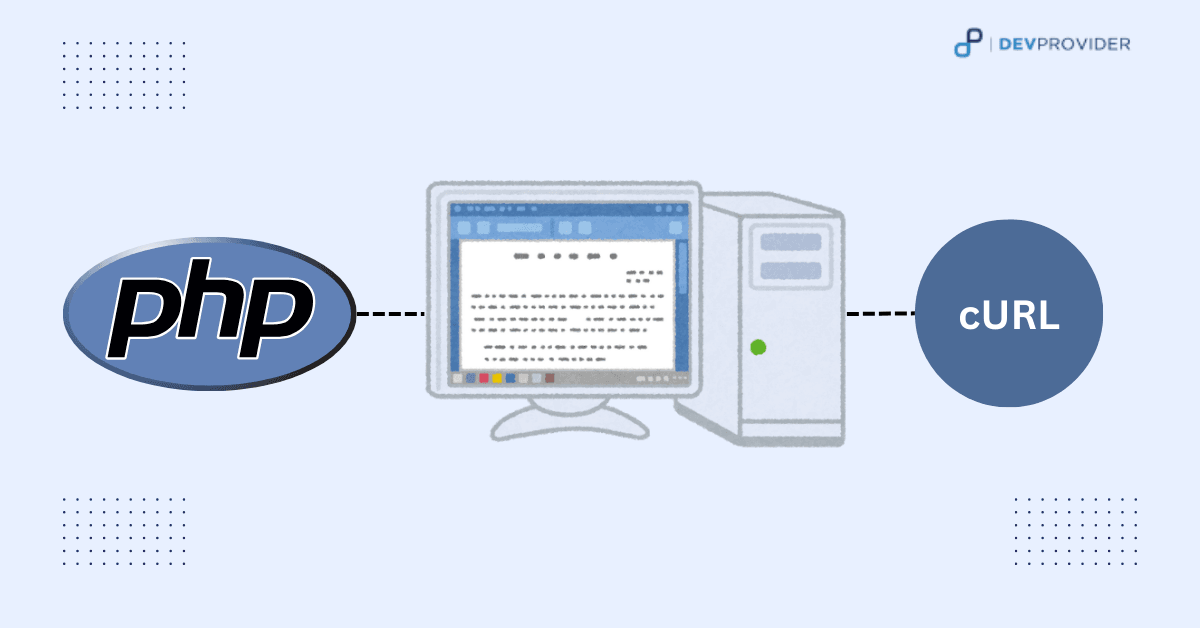
What is PHP cURL: Uses, Basic Concepts and Authentication

What is PHP cURL?
cURL (Client URL) is a powerful library that facilitates data transfer across various protocols such as HTTP, FTP, and more. Originally released in 1997 by Daniel Stenberg, the cURL project includes two components: a command-line tool and the libcurl library. While the command-line tool is commonly available in Linux distributions for transferring data over protocols like HTTP, HTTPS, and FTP, libcurl supports programmatic data transfer across multiple languages. In this article, we’ll focus on PHP cURL, which has been available since PHP version 4.0.2.
Functions of cURL in PHP
Here is a brief overview of key functions:
curl_init(): Initializes a cURL session.curl_setopt(): Sets options for a cURL session (e.g., URL, request method).curl_setopt_array(): Sets multiple options at once for a cURL session.curl_exec(): Executes the cURL session and performs the request.curl_close(): Closes a cURL session and frees resources.curl_errno(): Returns the last error number for a cURL session.curl_error(): Returns a string with the last error message from the session.curl_getinfo(): Gets information about the completed cURL session.curl_version(): Returns details about the cURL version and supported features.curl_reset(): Resets all options for a cURL session handle.
Uses of cURL in PHP
Downloading Data from URLs
- Fetch web pages, JSON, or other files.
- Useful for scraping data from websites.
Sending POST Requests
- Send data like form submissions or API payloads.
- Useful for interacting with remote servers.
Interacting with APIs
- Make GET, POST, PUT, or DELETE requests.
- Common for working with RESTful APIs.
Handling Cookies
- Maintain session cookies across requests.
- Store cookies in files or memory.
Managing SSL Connections
- Support secure HTTPS requests.
- Ensure safe communication with SSL certificates.
How to Use PHP cURL?
Here’s a breakdown of how to make POST and GET requests using PHP cURL.
PHP cURL POST Request
To make a POST request, follow these steps:
//Step 1 to initialize curl
$ch = curl_init();
//Step 2 to set url where you want to post
$url = ‘http://www.localhost.com’;
//Step 3 set curl functions which are needs to you
curl_setopt($ch,CURLOPT_URL,$url);
curl_setopt($ch,CURLOPT_POST,true);
curl_setopt($ch,CURLOPT_RETURNTRANSFER,true);
curl_setopt($ch,CURLOPT_POSTFIELD,’postv1 = value1&postv2 = value2’);
//Step 4 to execute the curl
$result = curl_exec($ch); //Step 5 close curl
curl_close($ch);PHP cURL GET Request
To make a GET request, follow these steps:
// Step 1: Define the URL for the GET request
$api = 'http://www.localhost.com';
// Step 2: Initialize curl session
$ch = curl_init();
// Step 3: Set curl options for GET request
curl_setopt($ch, CURLOPT_URL, $api);
curl_setopt_array($ch, array(
CURLOPT_RETURNTRANSFER => true,
CURLOPT_HTTPHEADER => 'Your Access Token',
CURLOPT_SSL_VERIFYPEER => false,
));
// Step 4: Execute the curl request
$result = curl_exec($ch);
// Step 5: Close the curl session
curl_close($ch);
Handling Cookies with PHP cURL
cURL can also handle cookies, which is useful when you need to maintain a session across multiple requests. You can store and send cookies using the following methods.
Set Cookies in a File
$ch = curl_init('http://example.com');
curl_setopt($ch, CURLOPT_RETURNTRANSFER, true);
// Save cookies in a file
curl_setopt($ch, CURLOPT_COOKIEJAR, 'cookie.txt');
$result = curl_exec($ch);
curl_close($ch);
Send Cookies with the Request
$ch = curl_init('http://example.com');
curl_setopt($ch, CURLOPT_RETURNTRANSFER, true);
// Use the cookie file from the previous request
curl_setopt($ch, CURLOPT_COOKIEFILE, 'cookie.txt');
$result = curl_exec($ch);
curl_close($ch);
Read about: PHP Framework Comparison
Making cURL Requests More Dynamic
// Dynamic POST data
$postData = http_build_query([
'field1' => 'value1',
'field2' => 'value2'
]);
curl_setopt($ch, CURLOPT_POSTFIELDS, $postData);
Error Handling with cURL
if(curl_errno($ch)) {
echo 'Curl error: ' . curl_error($ch);
} else {
echo 'Response: ' . $result;
}
Working with APIs
// Example: Sending POST request to a JSON API
$url = 'https://api.example.com/data';
$data = json_encode(['name' => 'John', 'age' => 30]);
$ch = curl_init($url);
curl_setopt($ch, CURLOPT_POST, true);
curl_setopt($ch, CURLOPT_RETURNTRANSFER, true);
curl_setopt($ch, CURLOPT_HTTPHEADER, ['Content-Type: application/json']);
curl_setopt($ch, CURLOPT_POSTFIELDS, $data);
$response = curl_exec($ch);
curl_close($ch);
echo $response;
Summary
In this article, we explored PHP cURL, a powerful tool for making web requests. Whether it’s sending POST requests, fetching data, handling cookies, or interacting with APIs, cURL simplifies the process. By understanding how to use cURL for various tasks like data transfer, session management with cookies, and API interactions, developers can create more dynamic and efficient web applications. Proper error handling and secure SSL usage are crucial for maintaining robust web communication.
If you’re looking to hire a skilled PHP developer or need expertise in any PHP framework such as Laravel, or CodeIgniter, feel free to contact us.
Tags: curl, cURL in web development, Handle cookies with cURL, php, php curl, PHP GET request, PHP POST request, web development

